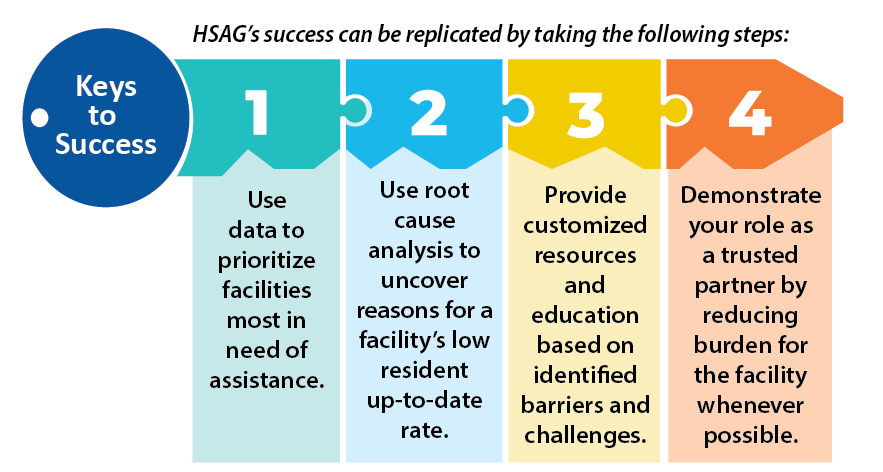A small, 26-bed skilled nursing facility in California with an average daily census of 23 residents, was referred by the Centers for Medicare & Medicaid Services (CMS) to Health Services Advisory Group (HSAG), a CMS Quality Innovation Network-Quality Improvement Organization (QIN-QIO), for assistance with improving its resident COVID-19 bivalent booster rate. Using root cause analysis, burden-reducing one-on-one assistance, and data, HSAG helped the facility realize a 42.65 percent net increase in its resident COVID-19 bivalent booster rate from the time the QIN-QIO made its initial outreach to the nursing home in January 2023 and the last report to the National Healthcare Safety Network (NHSN) in June 2023.
Identifying the Cause of the Facility’s Low Resident COVID-19 Bivalent Booster Rate
Using root cause analysis, HSAG determined the reason for the nursing home’s low resident COVID-19 bivalent booster rate was a recent change in ownership. In the six months following the change in ownership, the entire leadership team, including the administrator and director of nursing (DON) turned over. The infection preventionist (IP) turned over three times during this period, prompting the DON to take over the facility’s vaccination efforts. The nursing home struggled to prioritize vaccine clinics and have conversations with residents about the importance of getting vaccinated due to these leadership changes.
Connecting the new IP with a Local Pharmacy for On-Site Vaccination Clinics
Like many of the nursing homes experiencing turnover that HSAG assisted, the facility did not have a transition plan in place for its vaccination efforts. This meant new staff did not know who to reach out to or who the previous staff were working with to coordinate past vaccine clinics. Understanding the significant time and effort needed to research and identify new contacts at pharmacies or vaccine suppliers, HSAG leveraged its on-staff vaccine coordinator to reduce the burden on the facility. Based on his previous research and networking, the coordinator called his extensive list of contacts in the area and identified a pharmacy that was available for an on-site vaccine clinic. All that was required of the facility was to call and schedule a date for the clinic. As a result of HSAG’s assistance, the nursing home was able to host two clinics.
Providing Resources to Supplement One-on-One Assistance
In addition to one-on-one assistance, HSAG provided the facility with its Vaccine Change Package. This online resource offers podcasts and on-demand “quickinars,” such as the CMS Quality Improvement Voices Audio Series, a Motivational Interviewing Podcast, Vaccine Booster Messaging Quickinar and a Vaccine Hesitancy Quickinar. The Package also includes posters and flyers to display in the facility and an email/letter template staff can send to residents and their families to encourage vaccination. HSAG also encouraged the facility to participate in its monthly Office Hours and infection prevention webinar (in partnership with the California Department of Public Health), and to review the QIN-QIO’s monthly email blast with links to resources and events.
Using Data for Continuous Improvement
To ensure this and all nursing homes in HSAG’s region continue to see success, the QIN-QIO reviews data from NHSN and CMS. Using these data, HSAG produces weekly COVID-19 vaccine data reports to help nursing homes visualize their data inconsistencies, irregularities and outliers. HSAG also uses these data to categorize nursing homes into three tiers to prioritize outreach and maintain relationships with facilities. Tier 1 facilities are those showing zero residents who are up to date. This likely means there is a data error or help is needed to organize a vaccine clinic. Tier 2 facilities are those with a large shift in data. For example, 80 percent of residents were up to date in the previous week versus 40 percent who are up to date in the current week. Tier 3 facilities are those with an up-to-date rate below 40 percent. HSAG uses these three tiers to tailor outreach via phone calls and emails to find out what barriers these facilities are facing. Based on the feedback received, HSAG team members conduct research or share resources via email to help the nursing homes overcome their challenges and increase their up-to-date rate.

Regional Impact of HSAG’s Assistance
Per the NHSN weekly report dated August 20, 2023, the percentage of residents who are up to date in nursing homes that received assistance from HSAG increased by 10.2 percent as compared to the average change in resident vaccination across all nursing homes in HSAG’s region.
This material was prepared by The Bizzell Group (Bizzell), the Data Validation and Administrative (DVA) contractor, under contract with the Centers for Medicare & Medicaid Services (CMS), an agency of the U.S. Department of Health and Human Services (HHS). Views expressed in this material do not necessarily reflect the official views or policy of CMS or HHS, and any reference to a specific product or entity herein does not constitute endorsement of that product or entity by CMS or HHS. 12SOW/Bizzell/DVA-1179-08/23/2023.

